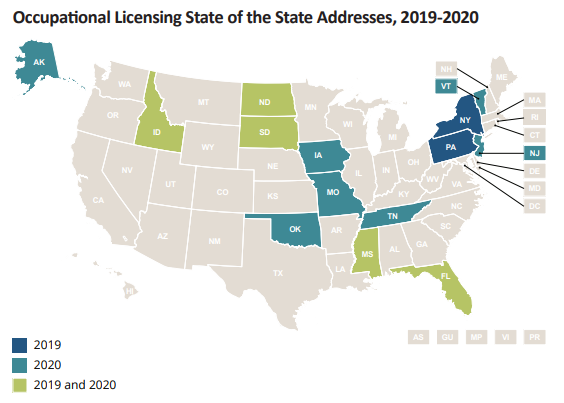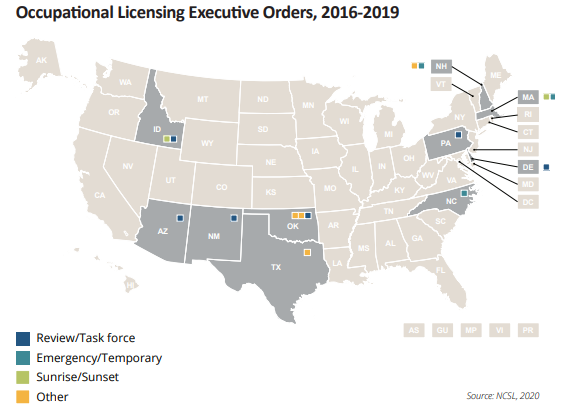The Occupational Licensing Final Report: Assessing State Policies and Practices highlights lessons learned from the consortiums’ work with 16 states that can inform future action by Governors and state legislators as they seek to expand access to good jobs and fill workforce needs in critical industries during recovery.
by Madelyn Rahn, Policy Analyst, NGA Center for Best Practices Workforce Development and Economic Policy Program
The early days of the COVID-19 pandemic highlighted how inefficiencies and barriers in occupational licensing can contribute to labor shortages in critical sectors. In response, nearly every Governor took rapid action to meet the dramatic surge in demand for health care workers by expanding flexibility in occupational licensing requirements. While many adjustments were designed to be temporary, these changes have raised the question of whether broader, longer-term action on licensing policy may promote a more responsive and equitable labor market in recovery.
Even before the pandemic, Governors were modifying occupational licensing policies to enhance workforce market mobility and expand opportunities for workers. In 2017, the National Governors Association Center for Best Practices (NGA Center) partnered with the National Conference of State Legislatures (NCSL) and the Council of State Governments (CSG) to facilitate an Occupational Licensing Learning Policy Consortium funded by the United States Department of Labor. Consortium states reviewed licensing policies and processes, focusing on reducing barriers to employment for veterans and military spouses, people with criminal records, immigrants with work authorization, and low-income and dislocated workers. States also identified specific industries to focus on, such as healthcare and cosmetology, and many explored opportunities to recognize licenses from other states.
Many of the issues examined through this project have gained broad bipartisan interest over the past several years, and this interest may grow as policymakers work to shape a strong post-pandemic recovery. The Occupational Licensing Final Report: Assessing State Policies and Practices highlights lessons learned from the consortiums’ work with 16 states that can inform future action by Governors and state legislators as they seek to expand access to good jobs and fill workforce needs in critical industries during recovery.
Governors can play a leading role in advancing these efforts by:
- Setting the agenda on occupational licensing reform;
- Using their executive power to take direct action; and
- Leading cross-branch initiatives that engage key stakeholders in occupational licensing.
Governor’s Role in Setting the Agenda
Governors can use their state of the state address to make occupational licensing reform a priority. Eight Governors mentioned occupational licensing in their state of the state addresses in 2019. During legislative sessions that year, relevant legislation was introduced in each of those states and was passed in six of the eight. This indicates the strong influence governors had on legislative action. In 2020, 13 Governors mentioned occupational licensing in their address. While these mentions did not corelate with the same degree of success in promoting legislative action (possibly due to changing priorities brought about by the pandemic) the demonstrated growing bipartisan interest could lead to significant policy changes in years to come.

In his 2019 state-of-the-state address, Pennsylvania Governor Tom Wolf said: “If a business can’t hire a worker because of an out-of-date or unnecessary rule or regulation, we need to know about it so we can take action.” That year, Gov. Wolf signed into law one of the most comprehensive occupational license endorsement bills any state has enacted to date. This historic action is a testament to the role clear gubernatorial priorities can play in legislative agenda-setting and meaningful policy change.
Governors’ Use of Executive Power
In addition to setting priorities for the legislature, Governors can use their executive order authority to address occupational licensing reforms directly. From 2016 to 2019, 10 Governors issued 15 executive orders related to occupational licensing. Most commonly, Governors used their executive authority during this period to mandate a statewide review of their occupational licensing system, identify challenges within the state’s licensing systems and processes and inform subsequent policy action.

Governors also used executive orders to address anticipated labor shortages in the face of emergency. In 2020, nearly every state implemented some sort of temporary flexibility in healthcare licensing, mostly by executive order. This strategy proved critical in ensuring adequate capacity to respond to the pandemic, and some states may consider making these temporary changes permanent or expanding flexibilities to other industries. Actions states have taken include:
- Modifying requirements to expedite the renewal process for expired licenses;
- Allowing medical professionals to practice in their state if they hold a valid license in another state; and
- Expanding activities that medical staff and students are allowed to perform.
Idaho Governor Brad Little made occupational licensing a clear priority when he issued two executive orders soon after taking office in January 2019: The Licensing Freedom Act of 2019 established a sunrise and sunset review process. The Red Tape Reduction Act requires state agencies that have authority to issue administrative rules to identify at least two existing rules to be repealed or significantly simplified for every one rule they propose.
Governors’ Leadership in Cross-Branch Occupational Licensing Initiatives
States in the Consortium benefitted from having a representative from their Governor’s office on their team to work alongside state legislators, board members and labor agency representatives. From 2017-2019, occupational licensing related legislation introduced in Consortium states ended up being enacted at a significantly higher rate as compared to in other states. This indicates that Consortium states were engaging the right stakeholders to support meaningful action on these issues. As states look for ways to promote opportunities for workers and proactively address skills gaps in critical industries like healthcare during the recovery, they should work across relevant stakeholders in collaboration with their Governor’s office to make occupational licensing a priority and develop shared commitments for policy change.
In Arkansas, Governor Asa Hutchison established the Governor’s Red Tape Reduction Working Group (RTRWG) in 2019. Gov. Hutchinson appointed Arkansas’ NGA-NCSL-CSG Consortium participants to the Occupational Licensing Advisory Group, which was tasked with advising the RTRWG. This collaboration led to the passage and enactment of The Red Tape Reduction Sunrise and Sunset Act of 2019, which was informed by the information-sharing the state team engaged in through the Consortium.












